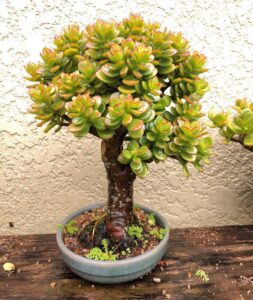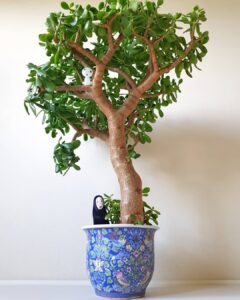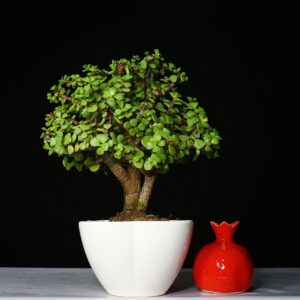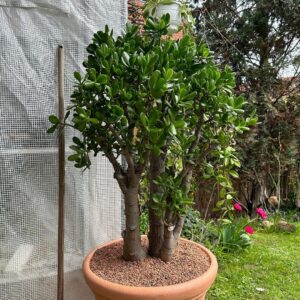Read the expert Tips for Growing a Jade Plant into a Tree with the help of this comprehensive guide and have an elegant Crassula Tree Bonsai.
Looking to add a Crassula tree bonsai to the plant collection? Discover essential Tips for Growing a Jade Plant into a Tree. From training techniques to proper care, this guide offers straightforward advice for transforming your jade plant into a magnificent tree-like specimen. Learn how to nurture its growth and create a stunning natural masterpiece.
Read Ylang-Ylang Tree Growing and Care Guide
Can a Jade Plant be Trained to Grow as a Tree?

Growing a jade plant as a tree requires a combination of training, pruning, feeding, and patience. It takes time to develop into a splendid specimen. In their natural habitat in Africa, jade plants can naturally reach 6-8 feet in height. With proper care, it can have a long lifespan and be passed down through generations.
Read Tips for Growing Apple Trees in Pots
Tips for Growing a Jade Plant into a Tree

1. Select the Right Variety for Growing a Jade Plant into a Tree
Do remember that not all jade varieties have a tree-like growth. Examples include Crassula Ovata, which can reach 4-8 feet, ‘Hummel’s Sunset’ at 3-5 feet; Portulacaria afra at 2-4 feet; and Crassula Ovata ‘Lemon & Lime’ at 3-5 feet tall.
2. Train the Trunk
Growing a jade plant into a tree shape involves specific steps:
- Select the main stem as the central trunk and remove the side stems.
- Initially, trim away stems that might hinder the main stem/trunk’s growth.
- Trim the lower portion of the plant, including leaves and stem, for a tree-like appearance.
- Support the main stem with something like a bamboo stick, as the plant can become top-heavy.
3. Choose the Right Pot
Initially, a jade plant does well in a 4 to 6 inches container. As it grows a bit, and if you want Jade Plant to take on a tree-like form, provide more space for its roots. Once the plant is a bit larger, move it to an 8 to 14 inches pot – the exact size depends on your specific jade plant.
Opt for a pot just one or two sizes larger than the current one. Going for a too-big container can lead to excess soil and moisture retention, causing waterlogging, which isn’t good for the jade plant. The safest choice is a pot that is one size bigger than the plant’s root ball.
4. Feed Right
Apply a balanced liquid fertilizer to your jade plant every 2-4 weeks when it’s actively growing. Dilute the fertilizer to a quarter of the recommended strength. This feeding routine will accelerate growth, leading to a tree-like form.
Remember not to overfeed. If you’re in a climate with frost or cold winters, stop fertilizing from mid-fall until winter.
5. Provide a Lot of Sunlight
The Jade plant, being a succulent, benefits from a fusion of direct and indirect sunlight. If possible, ensure even top-down light exposure to encourage upright growth.
When the light comes from the side, the plant tends to lean and extend sideways, reaching for the light. This can lead to the development of new side stems.
Using a stake is another approach to provide support and discourage sideways or downward growth, encouraging a straight and tall posture. This also aids in thickening and strengthening the main stem.
Points to Remember While Pruning Jade Plant to Turn into a Tree

Key Points for Pruning Jade Plants to Achieve a Tree-like Form:
- Pruning shapes the plant, enhances airflow, and guards against pests.
- Prune anytime, but spring and summer are best when growth is active for better healing.
- Limit trimming to 20-30% of branches in one session.
- Clean shears with rubbing alcohol to prevent infection from dirty tools.
- When removing a branch, cut it at the point where it joins the trunk.
- Trim the top of the trunk to encourage lateral growth, resulting in new branches for a lush, full appearance.
- Jade plants are easily propagated from both cuttings and leaves for creating new plants.
Read How to Grow Toona Sinensis ‘Flamingo’ Tree
Jade Tree as Bonsai

You can use bonsai wires to shape your tree as desired. These wires are user-friendly and aid in molding the stem’s shape from an early stage, promoting stronger and sturdier growth as the tree develops.
When dealing with bonsai jade, expect a compact and small appearance resembling a miniature tree. You have the freedom to determine its shape. Place it close to a well-lit window in your home or office.
Read Tips to Grow a Papaya Tree
Maintenance of Jade Plant as a Tree
- Maintain balanced watering; water when the topsoil is fully dry. Over and under-watering can harm the jade plant.
- Ensure the bonsai jade receives 3-4 hours of direct sunlight. Avoid complete darkness or heavy shade for better outcomes.
- Watch for spider mites and scales. Use insecticidal soap or strong water pressure to address these issues.
- Stay alert for powdery mildew and black ring disease. Prune affected areas with a sharp shear.
- Every 15-20 days, wipe the main trunk using a damp cloth to remove dirt, debris, and potential pests.
How Long will it Take for a Jade Plant to Turn into a Tree?

Under the right growing conditions, the jade plant will gradually take a tree-like form in about 3-4 years. However, it will take its own time, spanning 6-12 years, to grow to a height of 3-5 feet. The duration of this growth process also hinges on the plant’s size when initially acquired from the garden center.
Read the Mango Tree Care Guide
FAQs
Q1: Can I grow a jade plant into a tree indoors?
A1: Yes, you can grow a jade plant indoors. Ensure it receives ample sunlight, ideally near a sunny window. Consider using artificial grow lights if natural sunlight is limited.
Q2: How often should I water my jade plant when training it into a tree?
A2: Water your jade plant when the topsoil feels dry to the touch. Overwatering can lead to root rot, so allow the soil to dry out between waterings.
Q3: Can I use regular soil for my jade plant?
A3: Jade plants thrive in well-draining soil. Use a cactus or succulent mix, or amend regular potting soil with sand or perlite to enhance drainage.
Q4: Can I use bonsai techniques on other types of plants?
A9: Yes, bonsai techniques, such as wiring and shaping, can be applied to various types of plants to control their growth and create miniature versions. However, each plant may have specific care requirements.
Q5: Can I place my bonsai jade plant outdoors?
A11: Yes, you can place your bonsai jade plant outdoors during warmer months. However, ensure it receives the right amount of sunlight and protection from extreme weather conditions.
Q6: Is it possible to shape a jade plant into different tree forms, like a bonsai pine tree?
A12: While jade plants naturally have a different growth pattern than pine trees, with proper pruning and training, you can experiment with different tree-like shapes, including variations of bonsai styles.



